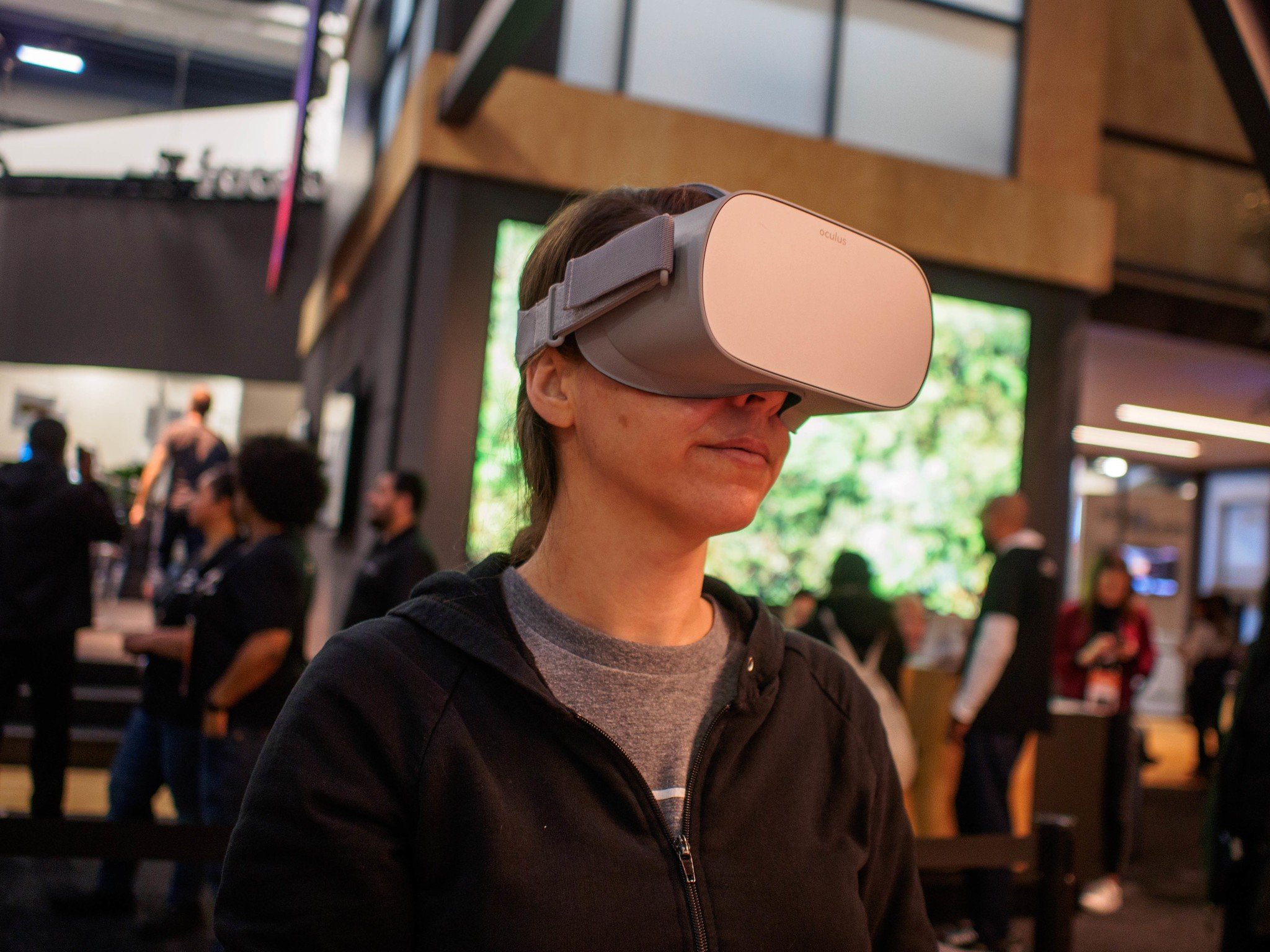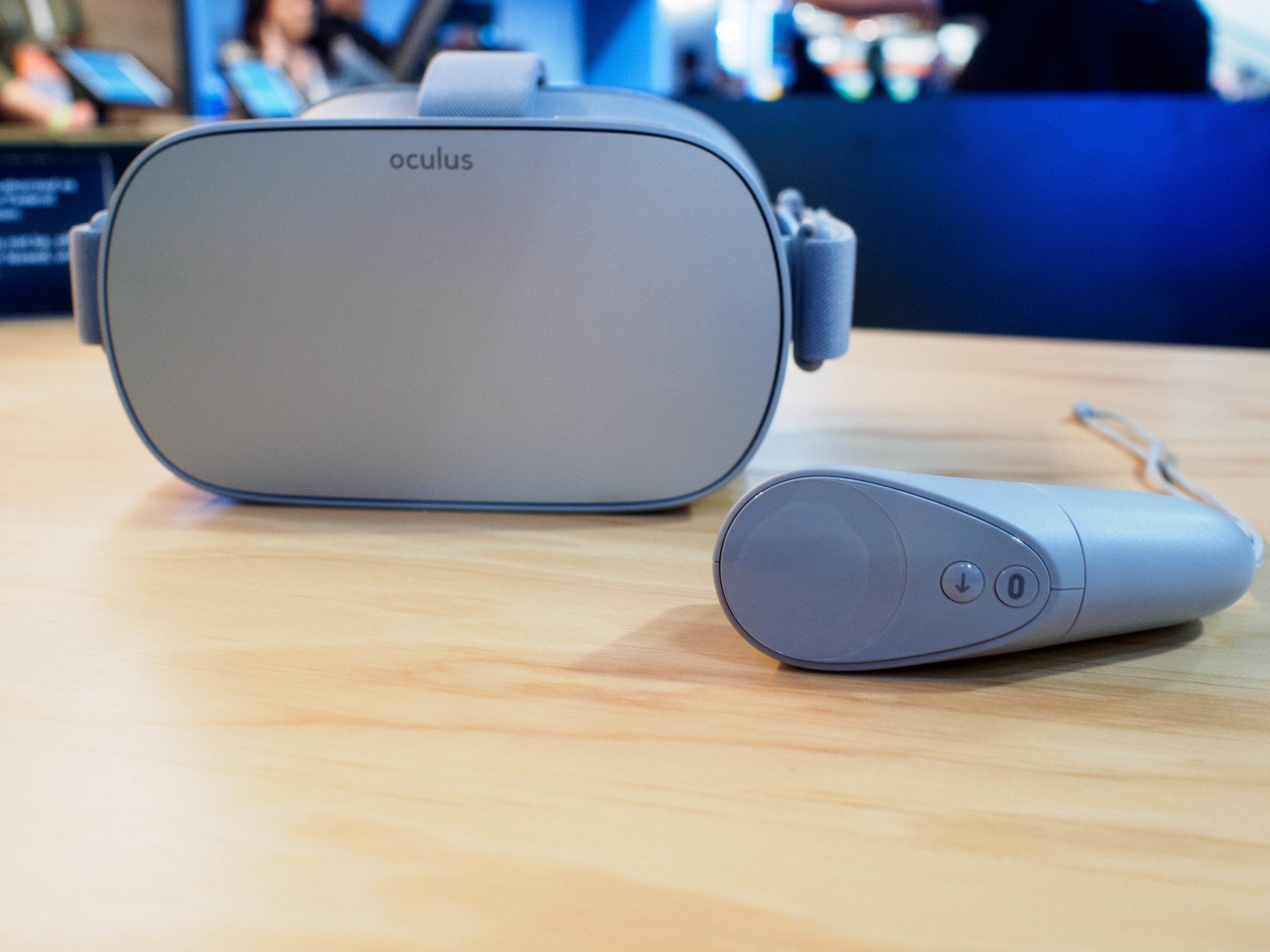The right fit. The right quality. The right price. This is going to be a hit.
Great standalone VR experiences are quickly defined by how comfortable the headset is, the volume and quality of available games, and the price of the headset. Oculus has been working hard to make sure its upcoming Go headset ticks all of these boxes, and at GDC 2018 the Oculus booth puts this headset front and center to demonstrate how successful that experience will be.
After a few minutes in these demos and some conversations with developers bringing games to the new headset, it's clear Oculus is gearing up for this launch to be a huge success.
The Hardware
Oculus Go is a standalone headset, which means the computer is built in. There's no phone to insert, no computer to connect to, and no accessories to attach. You push the the power button on the top of the headset, and the software immediately springs to life. It doesn't get much simpler.
Whatever Oculus has done to make these speakers work is impressive, because they are fantastic and people are going to love them.
Because the computer is baked right in, the headset is a little heavier than you might expect by looking at it. Oculus Go has a largely plastic body, with a little bit of fabric and rubbery material where you put your eyes. It doesn't scream "premium" when you look at it, but the design is undeniably Oculus. Right down to the unique shapes made by the straps and the rails on the sides, this looks like the younger brother to the Oculus Rift — which helps add some surprise when you lift the body and discover it's about the same weight.
With the power and volume buttons up top and the Micro-USB port exposed next to the headphone jack on the side, it's clear the design is less about aesthetics and more about functionality. What you won't find on the body is side buttons for navigating the Oculus UI. Everything you do inside the actual headset is controlled through the included Three Degrees of Freedom (3DoF) controller. If you've ever used the Gear VR controller, it will feel familiar enough, but this design is a little more cylindrical, with buttons more flush against the body.
While the headset has a headphone jack, you might never feel the need to use it. Oculus Go has spatial audio speakers built in, and possibly the greatest trick to this design is how well those speakers are hidden. You won't see any obvious speaker holes in the design because they're built into the straps. They're loud, too. Sitting in a noisy convention center hall did very little to stop them from totally immersing me in the game I was playing. Whatever Oculus has done to make these speakers work is impressive, because they are fantastic and people are going to love them. At the same time, I'm very happy there's an actual headphone jack for private VR sessions.
The inside of the Oculus Go is just about as close to perfect as you can get with something this size. The lenses are surrounded by a dark, matte black material that works hard to keep light from reflecting around it. This is a problem with a lot of other headsets, and it's refreshing to see it so well done here. Very little light leaks into the headset from outside, and very little light from within illuminates the surface around the lenses. This means you get nice deep black borders around the lenses, which helps make them feel larger than they are. They don't seem appreciably different from the Gear VR lenses on the outside, but when you combine the way Oculus Go increased the eye buffer to 1280x1280 (Gear VR is 1024x1024) with the way it decreased light problems on the other side of the lenses, you get a more immersive VR experience.
Oculus Go feels like the culmination of years of research from prior Oculus releases, including many Gear VR and Oculus Rift revisions. The headset itself feels almost minimalist compared to its other designs, no doubt an effort to keep costs down, which makes every inch of this headset useful in some way. Even the face gasket, the part which rests on your skin, feels somehow more purposefully designed. The rubbery material will be easy to clean, and the way the material flexes helps keep you from tightening the headset down too far on your face.
The Software
Put simply, we don't know much about the software yet. Oculus wasn't allowing anyone to take a trip through the home UI, but there are a few things we do know for sure. First, this headset is built on a custom version of Android most people are never going to see. When you turn the headset on, expect to see a very Oculus-like store and navigation panel. Think of the interface on a game console made by Oculus, and you'll have a good idea of what to expect when this headset is finally available.
We also know Oculus is focusing hard on three big things for the launch of this headset. The first we learned back at Oculus Connect 4 last October: the company wants developers to bring as many Gear VR games as possible to Oculus Go so the store looks nice and full at launch. Second, Oculus has been working with third-party developers to create experiences that encourage users to put the headset on every day. This can be competitive games, replayable games, or apps with a deeply social aspect, but either way, Oculus wants to make sure people have lots of reason to make sure the headset is constantly used and people want to bring it with them places. Third, Oculus wants to keep the social momentum going with Oculus Go. Being able to play games, watch moves, or just chat in a visual space with friends have all been cool ideas on the other headsets, but on Go these experiences will take priority.
To help drive these ideas home, the big Oculus Go demos this week are Catan VR, Anshar Online, and They Suspect Nothing. Catan VR, as the name suggests, lets you play the Settlers of Catan board game with up to four other people. The "board" includes a real-time chat system, and works cross-platform with Gear VR and Oculus Rift. They Suspect Nothing is a clever, funny robot infiltration game with a ton of replayability due to the random nature of the challenges. Anshar Online, a continuation of the excellent Anshar Wars VR franchise, is a space dogfight game you can now play with lots of other people in spectacular space battles that encourages you to spin all around and blow up everything.
The gameplay for each of these examples felt higher quality than what you would normally get on a Gear VR, but not by any massive amount. The visuals were nice, the text seemed clearer and the "corners" of the display lacked the blur you normally see with the Gear VR. The graphics themselves didn't seem any better, but visually the games played a little smoother and felt a little sharper.
There's obviously a lot more about the software to explore as the Oculus Go comes closer to launch, but these hand-picked Oculus demos paint a great picture of what this headset can do.
Get excited now
While the headset looks a feels minimalist, the experience this headset is delivering for $200 can't be beaten. A standalone headset is infinitely more practical than a headset you put your phone into for a lot of people, if only because it's difficult to be OK with giving 50% of your phone battery to something that isn't critical to your day-to-day activities. But when the headset has its own battery, you can treat it like a portable game console or a tablet and enjoy it without real consequences. For that standalone experience to not only be more practical than a phone-based system, but also generally more visually appealing, is damned impressive.
There will be folks out there eager for more capable standalone VR experiences, like the Oculus Santa Cruz prototypes or HTC Vive Focus or Daydream Standalone headsets, but Oculus Go is going to own the "entry level" VR market for a long time based on the experiences I've had today. This is a great experience at a killer price, and I will absolutely be standing in line to pick one up on launch day.
from Android Central - Android Forums, News, Reviews, Help and Android Wallpapers http://ift.tt/2FV3vWe
via IFTTT






No comments:
Post a Comment